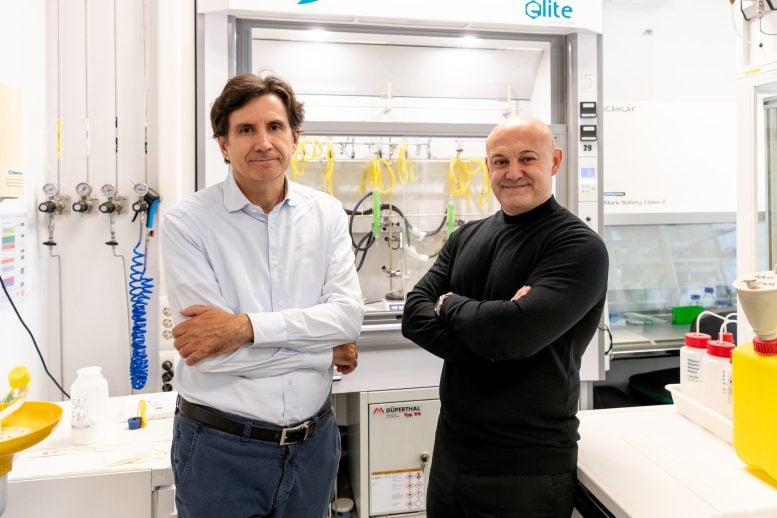AG5, a new anti-inflammatory compound developed in response to the COVID-19 pandemic, offers a safer alternative to corticosteroids like dexamethasone. It effectively inhibits cytokine storms while preserving innate immunity, showing potential in treating various inflammatory diseases and in CAR T-cell therapy.
AG5 inhibits the cytokine storm similarly to corticosteroids, but unlike them, it adequately preserves innate immunity.
Early in the COVID-19 pandemic, clinical trials with hospitalized patients revealed that corticosteroids, such as dexamethasone, decreased death rates. However, their use at the onset of COVID-19 symptoms proved detrimental. This was attributed to the suppression of the body’s natural antiviral defenses, resulting in slower viral elimination and negative consequences in cases of severe viral pneumonia.
In this scenario, in March 2020 the Spanish National Research Council (CSIC), launched “Global Health” Interdisciplinary Platform (PTI) dedicated to fighting the pandemic, covering all aspects of the crisis, from social to therapeutic. One of the virtues of this platform was to connect multiple CSIC researchers of different fields, University Professors, and some hospitals in Spain and bring their expertise, laboratories, and facilities to the service of the best ideas and initiatives, selected by a committee of highly qualified experts.
Development of AG5
Now, a multidisciplinary team, composed of some research groups from different CSIC institutes, the Universitat Politècnica de València, as well as other academic and clinical institutions, and led by Prof. Jose María Benlloch (I3M) and Dr. Pablo Botella (ITQ), has presented AG5, a novel non-steroidal anti-inflammatory (NSAID) and selective immune regulator compound.
The main novelty of AG5 is to open a new class of anti-inflammatory drugs. Contrary to NSAIDs, AG5 is capable of inhibiting the cytokine storm, like dexamethasone, but, unlike corticosteroids, preserves adequately the innate immunity. This is critical at the early stages of any naïve infection since the body needs to develop a defense response against the new pathogen. AG5 was selected through a careful screening study from other similar structural andrographolide derivatives, to enhance efficacy while minimizing toxicity. This new compound is a promising therapeutic alternative to dexamethasone (and in general, corticosteroids), with much less adverse effects and toxicity, and preserving the immune innate system.
In vitro testing has shown that AG5 is an inhibitor of caspase-1 and is able to modulate the immune response in inflammation processes associated to bacterial and viral infection. Moreover, the therapeutic efficacy of AG5 has been shown in different animal models of inflammation (zebrafish, mouse), with and without associated viral infection. For instance, AG5 is able to inhibit the cytokine storm in SARS-CoV-2-infected humanized mice without whole suppression of the immune response.
AG5 is expected to be very useful in the treatment of chronic inflammatory diseases, such as rheumatoid arthritis, Crohn’s disease, lung inflammation, and fatty liver disease. Moreover, AG5 has been proposed for prevention and treatment of the cytokine storm in CAR T-cell therapy.
Publication
AG5 results have been published in the journal Biomedicine and Pharmacotherapy of Elsevier. An initial Spanish patent was granted in 2023, and its extension through international patent application (PCT) has recently entered the National Phase through European and USA applications. In addition, another European patent application has been recently filed.
Development stage of AG5
Currently, the preclinical research with AG5 is almost completed, including the toxicology study in different validated animal models (mouse, rat, and rabbit), and the scaling up for the industrial production of this drug is ongoing. An application to the Spanish Agency of Medicaments and Health Products (AEMPS) for a Phase I/ II clinical study to test safety and efficacy in patients with fatty liver disease is foreseen by 2024.
How is the new drug AG5?
AG5 is a synthetic sulfonic derivative of andrographolide, the active principle of the Andrographis paniculata plant, endemic to certain regions in India, Sri Lanka, and other areas in South East Asia. From a therapeutic point of view, the sulfonic derivative presents significant advantages, as it is expected to notably increase the anti-inflammatory activity, also improving the pharmacokinetic profile with regard to the pristine chemical.
Reference: “AG5 is a potent non-steroidal anti-inflammatory and immune regulator that preserves innate immunity” by Pablo Botella-Asunción, Eva M. Rivero-Buceta, Carla Vidaurre-Agut, Raquel Lama, Magalí Rey-Campos, Alejandro Moreno, Laura Mendoza, Patricia Mingo-Casas, Estela Escribano-Romero, Alfonso Gutierrez-Adan, Juan Carlos Saiz, Cristian Smerdou, Gloria Gonzalez, Felipe Prosper, Josepmaría Argemí, Jesus San Miguel, Pedro J. Sanchez-Cordón, Antonio Figueras, Jose Manuel Quesada-Gomez, Beatriz Novoa and Jose María Benlloch, 18 November 2023, Biomedicine & Pharmacotherapy.
DOI: 10.1016/j.biopha.2023.115882
This work has been supported by NextGenerationEU Recovery and Resilience Facility through the PTI+ Global Health Platform of Spanish National Research Council, and by Generalitat Valenciana through the program “Ayudas urgentes para proyectos de investigación, desarrollo tecnológico e innovación (I+D+i) por la COVID-19”, with different projects whose principal investigator is Dr. Pablo Botella (ITQ). Also, this work has been funded by the FONDO SUPERA COVID-19 (IP, Dr. Jesus San Miguel, Clínica Universidad de Navarra), and by Severo Ochoa Center of Excellence Program (ITQ).






